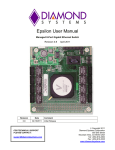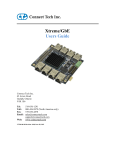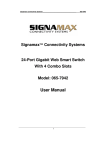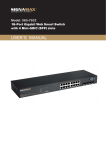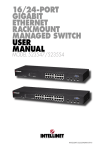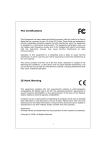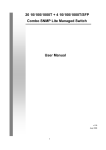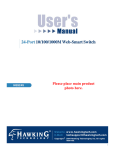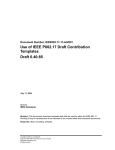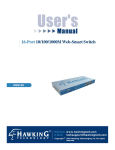Download user manual
Transcript
24-Port Gigabit Ethernet Switch User Manual Page 1 / Total 36 TABLE OF CONTENTS 1 INTRODUCTION ............................................................................................................................... 3 1.1 Terms and Definitions ....................................................................................................... 3 1.2 Abbreviations and Acronyms ............................................................................................ 3 2 FUNCTIONAL DESCRIPTION ......................................................................................................... 4 2.1 PHY Monitoring and Port Mode Set-up............................................................................ 4 2.2 Flow Control ..................................................................................................................... 4 2.3 Ageing ............................................................................................................................... 4 2.4 VLAN................................................................................................................................ 4 2.5 Link Aggregation .............................................................................................................. 5 2.6 Quality of Service ............................................................................................................. 5 2.7 Test Functions ................................................................................................................... 5 3 COMMAND LINE INTERFACE........................................................................................................ 6 3.1 Com Port Set-up................................................................................................................ 6 3.2 General.............................................................................................................................. 6 3.4 Detailed Command Description ...................................................................................... 12 3.5 Examples......................................................................................................................... 33 4 FACTORY DEFAULT CONFIGURATION ...................................................................................... 35 5 WEB INTERFACE ............................................................................................................................ 36 Page 2 / Total 36 1 INTRODUCTION 1.1 Terms and Definitions ● Smart switch is a switch with command line interface but without WEB interface. ● WEB Managed-Lite switch is a switch with both command line interface and WEB interface. ● The SPI and SI acronyms may be used interchangeably. 1.2 Abbreviations and Acronyms ARP CLI CPHA CPOL DHCP E2PROM IP LACP LED L2 MAC PCB PHY PVID QoS RAM ROM RSTP SFR SI SPI TCP UART UDP VID VLAN Address Resolution Protocol Command Line Interface Clock Phase Clock Polarity Dynamic Host Configuration Protocol Electrically Erasable Programmable Read Only Memory Internet Protocol Link Aggregation Control Protocol Light Emitting Diode Layer 2 Media Access Control Printed Circuit Board Physical Layer Transceiver Port VLAN Identifier Quality of Service Random Access Memory ReadOnly Memory Rapid Spanning Tree Protocol Special Function Register (8051 registers with special functionality) Serial Interface Serial Peripheral Interface Transmission Control Protocol Universal Asynchronous Receiver Transmitter User Datagram Protocol VLANIdentifier Virtual Local Area Network Page 3 / Total 36 2 FUNCTIONAL DESCRIPTION 2.1 PHY Monitoring and Port Mode Set-up It is a major task of the software to continuously monitor the PHYs in order to set up the switch ports according to whether the link is down or up and in the latter case what the current speed, duplex mode and pause capabilities are.PHYs are being polled every 100 ms. 2.2 Flow Control Flow control (back pressure) is supported both in full duplex and half duplex.Flow control can be enabled or disabled on a per-port basis from the command line interface or from the WEB interface. If flow control is enabled for a port the associated PHY will be set to advertise support of “Symmetric Pause”, but not “Asymmetric Pause”. If the station connected to the port also supports “Symmetric Pause”, flow control will be enabled on the switch port. Watermarks are set to hard-coded values. Different values are used depending on whether flow control is enabled or not and on current speed. 2.3 Ageing To prevent that an automatically learned MAC address of a station that has been detached will remain in the MAC address table permanently, the ageing function in the switch is activated on a regular basis. The period for doing the ageing function is determined by the ageing time parameter. Given the ageing mechanism in the switch, the period must be half the value of the ageing time parameter in order to make the ageing time parameter comply with IEEE 802.1D. For instance, if the ageing time parameter is 300 seconds, the period must be 150 seconds to ensure that an unused MAC address will not remain in the MAC address table for more than 300 seconds. The ageing time parameter can be set from the command line interface. Default value is 300 seconds. Setting the ageing time parameter to 0 disables the ageing function. 2.4 VLAN Port-based VLAN can be defined statically. GVRP (Generic/Group VLAN Registration Protocol) is not supported.A maximum of 16/24 VLANs can be stored in EEPROM. More than 16/24 VLANs may be defined, but they will not all survive a reboot. Page 4 / Total 36 2.5 Link Aggregation Link aggregation groups (or channels) can be defined statically. LACP (Link Aggregation Control Protocol) is also supported. Maximum number of aggregation groups is 8. The software will automatically detect that a link has gone down and then reassign packet distribution on the other links in the group. 2.6 Quality of Service Various classifications and prioritizations are supported in order to enable Quality of Service for real time applications such as VoIP (Voice over IP). 2.7 Test Functions Through the command line interface internal and external loopback tests can be run on the switch ports. In the internal loopback test the PHYs are set in loopback mode and the ports are set to copy frames to the CPU capture buffer. For each speed a single frame of fixed size (128 bytes) is sent from the CPU and it is checked that the frame is received in the CPU capture buffer within a proper time. If a port fails, an error code will be shown: 1, if the frame was received, but corrupted; 2, if the frame was not received. In external loopback test the ports must be connected pair-wise through external cables – port 0 and port 1 must be connected, port 2 and port 3 must be connected, and so on. Ports are tested pair-wise. A frame is sent from the CPU to a port and it is checked that the frame is received in the CPU capture buffer from the port’s counterpart within a proper time. A frame of fixed size (128 bytes) is sent for each speed. If a port fails, an error code will be shown: 1, if the frame was received, but corrupted; 2, if the frame was not received. Page 5 / Total 36 3 COMMAND LINE INTERFACE 3.1 Com Port Set-up To use the command line interface you may connect a PC COM port to the RS-232 connector and activate a terminal program, e.g. HyperTerminal under Windows. The COM port must be set up to run 8 data bits, 1 stop bit, no parity, 9600 baud and without flow control. 3.2 General 3.2.1 Command Hierarchy The CLI is hierarchical with two levels: a top level and a group level. The group level consists of the following groups: • System • Console • Port • MAC • VLAN • Aggregation • LACP • RSTP • User Group • QoS • Mirror • IP • Dot1X • Debug At top level you may enter a command by giving the full command string, including group, or you may change context into a group by entering the name of the group. At group level you may enter commands for the particular group you have chosen without specifying the group name or you may return to the top level by entering the up command. The current level and group is indicated by the prompt. If you are at the top level, the prompt will be: > If you are at group level, the prompt will display the actual group, e.g. System> At group level you also have the option of using the slash (/) key to refer to a context relative to the top Page 6 / Total 36 level. E.g. you may be in the system group and enter a /console/configuration command or change context into the console group by entering /console. 3.2.2 Login/Logout Procedures To get access to the CLI you must login by entering a password. You will automatically be queried about the password. The password is configurable. The password check may be disabled by setting the password to an empty string “”, in which case any password entered during login will be accepted. You may logout at any time and at any context level using the exit command. 3.2.3 Help Utility You may get help by pressing the ? key or entering help. The help info depends on the context: • At top level, a list of command groups is displayed. • At group level, a list of the command syntaxes for the current group is displayed. • If the help command is issued for a specific command, the command syntax and a description of the command are shown. 3.2.4 Example The command hierarchy and the help utility is demonstrated in the following example: > ? <enter> Commands at top level: System – System commands Console – Console commands Port – Port commands MAC – MAC table commands VLAN – VLAN commands Aggregation – Aggregation/Trunking commands LACP – IEEE802.3ad Link aggregation commands RSTP – IEEE802.1w Rapid Spanning Tree commands User Group – User Group commands QoS – QoS commands Mirror – Mirror commands IP – IP commands Dot1x – Dot1x commands Debug – Debug commands > console <enter> Page 7 / Total 36 Console> ? <enter> Commands at Console level: Console Configuration Console Password [<password>] Console Timeout [<timeout>] Console Prompt [<prompt string> Console> password ? Syntax: Console Password [<password>] Description: Set or display console password. The empty string (“”) disables the password check. [<password>]: Password string of up to 16 characters. Console> 3.2.5 Entering Commands • Commands are not case-sensitive. • You may use the horizontal arrow-keys ← and → to move the cursor within the command you are entering. • You may use the backspace key (provided you are using a terminal that sends the BS (8) character when the backspace key is pressed) to delete chars from the command you are entering. • You may use the vertical arrow-keys ↑ and ↓ to scroll through a command history buffer of the latest 20 commands issued. • If you are using a terminal (e.g. HyperTerminal) that supports <home> and <end> keys, you may use these keys to move the cursor to respectively the start of the command line and the end of command line. 3.2.6 Terminology The following table shows general parameter types used in command syntaxes and descriptions Page 8 / Total 36 the <port> Port identifier: Any number in the range 1-8/12/16/24 dependent on number of ports on the switch. <portlist> Comma and/or dash separated port list. This type can be used for specifying individual ports or a range of ports. The keyword ‘none’ can be used to specify an empty port list. The keyword ‘all’ can be used to specify all ports. Example: 1,3,8-12 <macaddress> MAC Address; format: “hh-hh-hh-hh-hh-hh”, “hh:hh:hh:hh:hh:hh” or “hhhhhhhhhhhh”. The hh is Hexadecimal number in the range 0x00 to 0xFF. Example: 00-00-24-F1-02-03 <vid> VLAN ID: Decimal number in the range 1-4095. The keyword ‘all’ can be used to specify all VLAN IDs <vidlist> Comma and/or dash separated VLAN ID list. This type can be used for specifying individual VLAN IDs or a range of VLAN IDs. The keyword ‘none’ can be used to specify an empty VLAN ID list Example: 1,2,4-6 <rate> Leaky bucket rate in Kbit/s [0-1000000k] or Mbit/s [0-1000m). Note! For Stapleford™ and Heathrow-III™ bucket rate is line-rate, i.e. sizes of interframe gap and preamble are included in the rate, whereas for Stansted™ and Elstree™ bucket rate is payload-rate, i.e. sizes of interframe gap and preamble are not included in the rate. <class> Internal class of service. The classes offered depend on the chip and the number of queues: 2 queues: low|high 4 queues: low|normal|medium|high <grouplist> Comma and/or dash separated user group list. This type can be used for specifying individual user groups or a range of user groups. The range is 1 to 5/8/12/16/24 <shared secret> A text string, with the purpose to ensure integrity for communication RADIUS server and the 802.1X switch authenticator. between a The <portlist> type is very useful when setting up multiple ports in the same mode. For example, the following commands will divide the ports into two untagged VLANs and enable VLAN awareness: vlan add 1 1-8 vlan add 2 9-16 vlan pvid 1-8 1 vlan pvid 9-16 2 vlan aware all enable 3.3 Command Overview ? Help Up Exit System Configuration [all] Page 9 / Total 36 System Restore Default [keepIP] System Name [<name>] System Reboot System SNMP [enable|disable] System Trap [<IP Address>] Console Configuration Console Password [<password>] Console Timeout [<timeout>] Port Configuration [<portlist>] Port Mode [<portlist>] [<speed>] Port Flow Control [<portlist>] [enable|disable] Port State [<portlist>] [enable/disable] Port MaxFrame [<portlist>] [<framesize>|reset]Port Statistics [<portlist>] [clear] Port VeriPHY [<portlist>] [full|anomaly|termination] MAC Configuration MAC Add <macaddress> <portlist>|none [<vid>] MAC Delete <macaddress> [<vid>] MAC Lookup <macaddress> [<vid>] MAC table <vidlist> MAC Flush MAC Agetime [<agetime>] VLAN Configuration [<portlist>] VLAN Add <vidlist> [<portlist>] VLAN Delete <vidlist> VLAN Lookup <vidlist> VLAN Aware [<portlist>] [enable|disable] VLAN PVID [<portlist>] [<vid>|none] VLAN Frame Type [<portlist>] [all|tagged] Aggr Configuration Aggr Add <portlist> Aggr Delete <portlist> Aggr Lookup <portlist> Aggr Mode [smac|dmac|xor] Lacp Configuration [<portlist>] Lacp Mode [<portlist>] [enable|disable] Lacp Key [<portlist>] [<key>|auto] Lacp Status Lacp Statistics Rstp Configuration [<portlist>] Rstp sysprio [<sysprio>] Rstp hellotime [<secs>] Rstp maxage [<hops>] Rstp fwddelay [<secs>] Page 10 / Total 36 Rstp version [normal|compat] Rstp Mode [<portlist>] [enable|disable] Rstp Aggr [enable|disable] Rstp Edge [<portlist>] [enable|disable] Rstp Pathcost [<portlist>] [<pathcost>|auto] Rstp mcheck <portlist> Rstp Status Rstp Statistics User Group Configuration User Group Add <grouplist> [<portlist>] User Group Delete <grouplist> User Group Lookup <grouplist> QoS Configuration [<portlist>] QoS Mode [<portlist>] [tag|iptos|port|diffserv|L4] QoS Default [<portlist>] [low|high] QoS Tagprio [<portlist>] [<tagpriolist>] [<class>] QoS Tosprecedence [<portlist>] [<tosprecedencelist>] [<class>] QoS DiffServ [<portlist>] [<dscplist>] [low|high] QoS Shaper [<portlist>] [disable | <rate>] QoS Policer [<portlist>] [disable | <rate>] QoS Storm Control [ICMP|Learn|Broadcast|Multicast|Flood Unicast] [disable | <rate>] Mirror Configuration Mirror Port [<port>] Mirror Source [<portlist>] [enable|disable] IP Configuration IP Setup [<ipaddress> [<ipmask> [<ipgateway>]]] [<vid>] IP Mode [enable|disable] IP ARP IP DHCP [enable|disable] Dot1x Configuration Dot1x Mode [enable|disable] Dot1x State [<portlist>] [Auto|ForceAuthorized|ForceUnauthorized] Dot1x Server [<IP Address>] Dot1x UDP Port [<value>] Dot1x Secret [<Shared Secret>] Dot1x Statistics [<portlist>] Dot1x Reauthenticate [<portlist>] [now] Dot1x Parameters [<parameter>] [<value>] IGMP Configuration IGMP Status IGMP Groups <vidlist> IGMP Mode [enable|disable] IGMP State <vidlist> [enable|disable] IGMP Querier <vidlist> [enable|disable] Page 11 / Total 36 IGMP Router ports [<portlist>] [enable|disable] IGMP Unregistered Flood [enable|disable] Debug Read Register <block> <subblock> <address> Debug Write Register <block> <subblock> <address> <value> Debug PHY Read <portlist> <address> Debug PHY Write <portlist> <address> <value> Debug Loopback [int|ext] 3.4 Detailed Command Description Some of the commands have optional parameters. If the optional parameter is omitted, a default value may be used or the command may display the current setting (i.e. function as a get command). Example 1, omitted parameter interpreted as display command: Syntax: System Name [<name>] >system name <enter> System Name: SuperSwitch-01 Example 2, omitted parameter interpreted as default value (VLAN ID 1): Syntax: MAC Add <macaddress> <portlist> [<vid>] >mac add 010203ABCDEF 16 <enter> The following sections list the individual commands by showing the syntax and a description of each command. 3.4.1 System Commands 3.4.1.1 System Configuration Syntax: System Configuration [all] Description: Show system name, software version, hardware version and management MAC address. Optionally show the full configuration [all]: Show the total switch configuration (default: System configuration only). 3.4.1.2 System Restore Default Page 12 / Total 36 Syntax: System Restore Default [keepIP] Description: Restore factory default configuration. [keepIP]: Preserve IP configuration (default: Not preserved). 3.4.1.3 System Name Syntax: System Name [<name>] Description: Set or show the system name. The empty string (“”) clears the system name. [<name>]: String of up to 16 characters (default: Show system name). 3.4.1.4 System Reboot Syntax: System Reboot Description: Reboot the switch. 3.4.1.5 System SNMP Syntax: System SNMP [enable|disable] Description: Activate or deactivate SNMP. [enable|disable]: Enable/disable SNMP (default: Show SNMP mode). 3.4.1.6 System Trap Syntax: System Trap [<IP Address>] Description: Set or show SNMP traps destination. [<IP Address>]: IP address to send traps to. 0.0.0.0 disables traps (default: Show trap destination). 3.4.2 Console Commands 3.4.2.1 Console Configuration Syntax: Page 13 / Total 36 Console Configuration Description: Show configured console password and timeout. 3.4.2.2 Console Password Syntax: Console Password [<password>] Description: Set or show the console password. The empty string (“”) disables the password check. [<password>]: Password string of up to 16 characters. 3.4.2.3 Console Timeout Syntax: Console Timeout [<timeout>] Description: Set or show the console inactivity timeout in seconds. The value zero disables timeout. [<timeout>]: Timeout value in seconds, 0, 60-10000. 3.4.2.4 Console Prompt Syntax: Console Prompt [<prompt_string>] Description: Set or show the console prompt string. The empty string (“”) clears the prompt string. [<prompt_string>]: Command prompt string of up to 10 characters. 3.4.3 Port Commands 3.4.3.1 Port Configuration Syntax: Port Configuration [<portlist>] Description: Show the configured and current speed, duplex mode, flow control mode and state for the port. <portlist>: Port list (Default: All ports). Page 14 / Total 36 3.4.3.2 Port Mode Syntax: Port Mode [<portlist>] [<mode>] Description: Set or show the speed and duplex mode for the port. <portlist>: Port list (Default: All ports). <mode> : Port speed and duplex mode (Default: Show configured and current mode). 10hdx : 10 Mbit/s, half duplex. 10fdx : 10 Mbit/s, full duplex. 100hdx : 100 Mbit/s, half duplex. 100fdx : 100 Mbit/s, full duplex. 1000fdx: 1 Gbit/s, full duplex. auto : Auto negotiation of speed and duplex. 3.4.3.3 Port Flow Control Syntax: Port Flow Control [<portlist>] [enable|disable] Description: Set or show flow control mode for the port. <portlist> : Port list (default: All ports). [enable|disable]: Enable/disable flow control (default: Show flow control mode). 3.4.3.4 Port State Syntax: Port State [<portlist>] [enable/disable] Description: Set or show the state for the port. <portlist> : Port list (default: All ports). [enable|disable]: Enable or disable port state (default: Show state). 3.4.3.5 Port MaxFrame Syntax: Port MaxFrame [<portlist>] [<framesize>|reset] Description: Set or show the maximum frame size in bytes (including FCS) for frames received on the port. Tagged frames are allowed to be 4 bytes longer than the maximum frame size. Use the reset option to return to the default setting. Page 15 / Total 36 [<portlist>] : Port list (default: All ports). [<framesize>|reset]: Maximum frame size or reset to 1518 bytes (default: Show maximum frame size). 3.4.3.6 Port Statistics Syntax: Port Statistics [<portlist>] [clear] Description: Show or clear statistics for the port. <portlist>: Port list (default: All ports). [clear] : Clear port statistics (default: Show statistics). 3.4.3.7 Port VeriPHY Syntax: Port VeriPHY [<portlist>] [full|anomaly|termination] Description: Perform VeriPHY cable diagnostics on the specified port(s). <portlist>: Port list (default: All ports). [full|anomaly|termination] : Type of diagnostics. Full comprises cable length and full anomaly check, anomaly comprises full anomaly check and termination comprises anomaly check without check for coupling between pairs (default: full). 3.4.4 MAC Table Commands 3.4.4.1 MAC Configuration Syntax: MAC Configuration Description: Show the permanently stored MAC table and the MAC ageing timer. 3.4.4.2 MAC Add Syntax: MAC Add <macaddress> <portlist>|none [<vid>] Description: Add a static MAC address table entry and VLAN ID on ports. Page 16 / Total 36 <macaddress>: MAC address, 12-digit hex string, optionally separated with dashes or colons (e.g. 010203ABCDEF or 01-02-03-AB-CD-EF or 01:02:03:AB:CD:EF). <portlist> : Port list. Use ”none” to specify no ports. [<vid>] : VLAN ID, 1-4095 (default: 1). 3.4.4.3 MAC Delete Syntax: MAC Delete <macaddress> [<vid>] Description: Delete MAC address and VLAN ID. <macaddress>: MAC address, 12-digit hex string, optionally separated with dashes or colons (e.g. 010203ABCDEF or 01-02-03-AB-CD-EF or 01:02:03:AB:CD:EF). [<vid>] : VLAN ID (default: 1). 3.4.4.4 MAC Lookup Syntax: MAC Lookup <macaddress> [<vid>] Description: Lookup MAC address and VLAN ID. <macaddress>: MAC address, 12-digit hex string, optionally separated with dashes or colons (e.g. 010203ABCDEF or 01-02-03-AB-CD-EF or 01:02:03:AB:CD:EF). [<vid>] : VLAN ID, 1-4095 (default: 1). 3.4.4.5 MAC Table Syntax: MAC Table <vidlist> Description: Show MAC table for the VLAN Ids specified. Since the list can be very long, only the first 20 entries are shown. <vidlist> 3.4.4.6 : VLAN ID list. MAC Flush Syntax: MAC Flush Page 17 / Total 36 Description: Removes non-static MAC address table entries. 3.4.4.7 MAC Age Time Syntax: MAC Agetime [<agetime>] Description: Set or show the MAC age timer in seconds. The value zero disables ageing. [<agetime>]: Age timer in seconds, 0 or 10-65535 (default: Show timer). 3.4.5 VLAN Commands 3.4.5.1 VLAN Configuration Syntax: VLAN Configuration [<portlist>] Description: Show the VLAN aware mode, port VLAN ID and accepted frame type for the port and the permanently stored VLAN table. [<portlist>]: Port list (default: All ports). 3.4.5.2 VLAN Add Syntax: VLAN Add <vidlist> [<portlist>] Description: Add VLAN entry and include ports in member set. <vidlist> : VLAN ID list. [<portlist>]: Port list (default: All ports). 3.4.5.3 VLAN Delete Syntax: VLAN Delete <vidlist> Description: Delete VLAN entry (all ports excluded from member set). <vidlist> : VLAN ID list. 3.4.5.4 VLAN Lookup Page 18 / Total 36 Syntax: VLAN Lookup <vidlist> Description: Lookup VLAN entry and show port list. <vidlist> : VLAN ID list. 3.4.5.5 VLAN Aware Syntax: VLAN Aware [<portlist>] [enable|disable] Description: Set or show the VLAN awareness mode for the port. VLAN aware ports will D the VLAN tag from received frames and insert the tag in transmitted frames (except PVID). VLAN unaware ports will not strip the tag from received frames or insert the tag in transmitted frames. [<portlist>] : Port list (default: All ports). [enable|disable]: Enable/disable VLAN awareness (default: Show awareness). 3.4.5.6 VLAN PVID Syntax: VLAN PVID [<portlist>] [<vid>|none] Description: Set or show the port VLAN ID. Untagged frames received on the port will be classified to this VLAN ID. Frames classified to this VLAN ID will be sent untagged on the port. [<portlist>]: Port list (default: All ports). [<vid>|none]: Port VLAN ID, 1-4095 (default: Show PVID). The ’none’ option can be used for trunk links. 3.4.5.7 VLAN Frame Type Syntax: VLAN Frame Type [<portlist>] [all|tagged] Description: Set or show the accepted frame type for the port. [<portlist>]: Port list (default: All ports). [all|tagged]: Accept all or only tagged (default: Show frame type). Page 19 / Total 36 3.4.6 Aggregation/trunking Commands 3.4.6.1 Aggregation Configuration Syntax: Aggr Configuration Description: Shows the aggregation groups and the aggregation mode. 3.4.6.2 Aggregation Add Syntax: Aggr Add <portlist> Description: Add link aggregation group including ports. <portlist>: Aggregation port list. 3.4.6.3 Aggregation Delete Syntax: Aggr Delete <portlist> Description: Delete link aggregation group. <portlist>: Port list. Aggregations including any of the ports will be deleted. 3.4.6.4 Aggregation Lookup Syntax: Aggr Lookup <portlist> Description: Lookup and display link aggregation group. <portlist>: Port list. Aggregations including any of the ports will be shown. 3.4.6.5 Aggregation Mode Syntax: Aggr Mode [smac|dmac|xor] Description: Set or show link aggregation traffic distribution mode. Page 20 / Total 36 [smac|dmac|xor]: Aggregation mode, SMAC, DMAC or XOR (default: Show mode). 3.4.7 Lacp Commands Lacp (IEEE 802.3ad Link Aggregation Protocol) provides a way to set up aggregation automatically between switches. 3.4.7.1 LACP Configuration Syntax: LACP Configuration [<portlist>] Description: Show the configuration of LACP on all or some ports. <portlist>: Port list. Default is all ports. 3.4.7.2 LACP Mode Syntax: LACP mode [portlist] [enable|disable] Description: Enable or disable LACP on all or some ports. <portlist>: List of ports to enable or disable LACP. Default is all ports. Enable|disable: Enable or disable LACP on the ports. 3.4.7.3 LACP Key Syntax: LACP key [<portlist>] [<key>|auto] Description: The key determines which ports potentially can aggregate together. 3.4.8 RSTP Commands RSTP is a protocol that prevents loops in the network and dynamically reconfigures which physical links in a switch should forward frames. 3.4.8.1 RSTP Configuration Syntax: RSTP Configuration [<portlist>] Description: Show the RSTP Configuration. 3.4.8.2 RSTP Sysprio Syntax: Page 21 / Total 36 RSTP Sysprio [<sysprio>] Description: Set or show the RSTP system priority. <sysprio>: Number between 0 and 61440 in increments of 4096. This provides for 16 distinct values: 0, 4096, 8192, 12288, 16384, 20480, 24576, 28672, 32768,36864, 40960, 45056, 49152, 53248, 57344 and 61440.The lower the system priority the more likely the switch is to become root in Spanning tree. 3.4.8.3 RSTP Hellotime Syntax: RSTP Hellotime [<secs>] Description: Set or show the RSTP Hellotime value. <secs>: Number between 1 - 10 (default is 2) 3.4.8.4 RSTP Maxage Syntax: RSTP Maxage [<secs>] Description: Set or show the RSTP MaxAge value. <secs>: Number between 6 - 40 (default is 20) 3.4.8.5 RSTP Fwddelay Syntax: RSTP Fwddelay [<secs>] Description: Set or show the RSTP Forward Delay value. <secs>: Number between 4 - 30 (default is 15) 3.4.8.6 RSTP Version Syntax: RSTP Version [<version>] Description: Set or show the RSTP default protocol version to use. <version>: normal - use RSTP, compat - compatible with old STP 3.4.8.7 RSTP Mode Syntax: RSTP Mode [<portlist>] [enable|disable] Page 22 / Total 36 Description: Set or show the RSTP mode for the designated ports. [<portlist>]: Port list (Default: All ports). [enable|disable]: Enable or disable. 3.4.8.8 RSTP Aggr Syntax: RSTP Aggr [enable|disable] Description: Set or show the RSTP mode for aggregated links. [enable|disable]: Enable or disable. 3.4.8.9 RSTP Edge Syntax: Rstp edge [enable|disable] Description: Expect the port to be an edge port (an end station) or a link to another STP device. [enable|disable]: End-station or bridge. 3.4.8.10 RSTP Pathcost Syntax: RSTP pathcost [<portlist>] [<pathcost>|auto] Description: Set or show the RSTP path cost for the designated ports. [<portlist>]: Port list (Default: All ports). [<pathcost>]: Number between 1 - 200000000. Auto means autogenerated pathcost Pathcost is normally reverse proportional to the physical (or aggregated) link speed. 3.4.8.11 RSTP Mcheck Syntax: RSTP Mcheck <portlist> Description: Force protocol renegotiations on the specified ports. <portlist>: Port list. 3.4.8.12 RSTP Status Syntax: Page 23 / Total 36 RSTP Status Description: Show the current state of all RSTP incarnations and the physical (and aggregation) ports that they control. 3.4.8.13 RSTP Statistics Syntax: RSTP Statistics Description: Show the current statistics of all RSTP BPDU frames received and transmitted on the physical (and aggregation) ports. 3.4.9 User Group Commands User groups provide another way than VLAN for making port grouping. With user groups it is possible to share a port between more user groups. An example on how to use user groups is given in chapter 3.5. 3.4.9.1 User Group Configuration Syntax: User Group Configuration Description: Show the user groups. 3.4.9.2 User Group Add Syntax: User Group Add <grouplist> [<portlist>] Description: Add user group entry including the ports. <grouplist> : User group ID list. [<portlist>]: Port list (default: All ports). 3.4.9.3 User Group Delete Syntax: User Group Delete <grouplist> Description: Delete user group entry. <grouplist>: User group ID list. Page 24 / Total 36 3.4.9.4 User Group Lookup Syntax: User Group Lookup <grouplist> Description: Lookup user group entry and show port members. <groupist>: User group ID list. 3.4.10 QoS Commands 3.4.10.1 QoS Configuration Syntax: QoS Configuration [<portlist>] Description: Show the configured QoS mode, IP ToS Precedence priority mapping, VLAN user priority mapping, default priority, default VLAN user priority [<portlist>] : Port list (default: All ports). 3.4.10.2 QoS Mode Syntax: QoS Mode [<portlist>] [tag|iptos|port|diffserv|L4] Description: Set or show the priority mode for the port. [<portlist>] : Port list (default: All ports). [tag|diffserv]: Enable tag or IP differentiated services (default: Show mode). 3.4.10.3 QoS Default Syntax: QoS Default [<portlist>] [<class>] Description: Set or show the default class. In tag mode, the default class is used for untagged frames. In port mode, the default class is used as the port priority. [<portlist>]: Port list (default: All ports). [<class>] : Internal class of service (default: Show class). Page 25 / Total 36 3.4.10.4 QoS Tagprio Syntax: QoS Tagprio [<portlist>] [<tagpriolist>] [<class>] Description: Set or show the VLAN user priority mapping. [<portlist>] : Port list (default: All ports). [<tagpriolist>]: VLAN user priority list, 0-7 (default: All user [<class>] 3.4.10.5 priorities). : Internal class of service (default: Show class). QoS DiffServ Syntax: QoS DiffServ [<dscplist>] [<class>] Description: Set or show the IP Differentiated Services mapping. [<dscplist>]: IP DSCP list, 0-63 (default: All DSCP values). [<class>] : Internal class of service (default: Show class). 3.4.10.6 QoS Shaper Syntax: QoS Shaper [<portlist>] [disable | <rate>] Description: Set or show the shaper configuration. [<portlist>] : Port list (default: All ports). [disable | <rate>] : Disable or set leaky bucket rate in Kbit/s [0-3968k] (default: Show shaper rate). 3.4.10.7 QoS Policer Syntax: QoS Policer [<portlist>] [disable | <rate>] Description: Set or show the policer configuration. [<portlist>] [disable | <rate>] : Port list (default: All ports). : Disable or set leaky bucket rate in Kbit/s [0-3968k] (default: Show policer rate). 3.4.10.8 QoS Storm Control Syntax: QoS Storm Control [ICMP|Learn|Broadcast|Multicast|Flood Unicast] [disable | <rate>] Description: Set or show the storm control configuration. The allowed frame rates for ICMP frames, learn frames, multicasts, broadcasts and flooded unicasts are controlled using a Page 26 / Total 36 central storm controller. [ICMP|Learn|Broadcast|Multicast|Flood Unicast] : Storm controller to set (default: Show all). [disable | <rate>]: Disable storm controller or set the rate in kiloframes Allowed values are 1k, 2k, 4k, 8k, 16k, 32k, 64k, 128k, 256k, 512k, 1024k, 2048k, 4096k, 8192k, 16384k, 32768k 3.4.11 Mirror Commands 3.4.11.1 Mirror Configuration Syntax: Mirror Configuration Description: Show the mirror destination port and mirror mode for source ports. 3.4.11.2 Mirror Port Syntax: Mirror Port [<port>] Description: Set or show the mirror destination port. [<port>]: Mirror destination port (default: Show mirror port). 3.4.11.3 Mirror Source Syntax: Mirror Source [<portlist>] [enable|disable] Description: Set or show the source port mirror mode. [<portlist>] : Source port list (default: All ports). [enable|disable]: Enable/disable mirroring of frames received on port (default: Show mirror mode). 3.4.12 IGMP snooping commands 3.4.12.1 Description on IGMP snooping Per default – and when enabled - IGMP snooping will function in each statically defined VLAN (i.e. those VLANs that are stored in non-volatile configuration memory). The IGMP snooping module will listen to IP Page 27 / Total 36 multicast router IGMP queries and the IGMP reports from hosts, and will update the switch device MAC table with IP multicast group MAC addresses and port masks according to the received reports. If no IP multicast router is present in an IGMP enabled VLAN, the switch will perform the querying itself in that particular VLAN. The switch querying functionality can be enabled and disabled per VLAN. The switch must be setup for IP management (see section 5.0) in order for the querying to work. 3.4.12.2 IGMP Configuration Syntax: IGMP Configuration Description: Show the IGMP configuration. 3.4.12.3 IGMP Status Syntax: IGMP Status Description: Show the IGMP operational status and statistics. 3.4.12.4 IGMP Groups Syntax: IGMP Groups <vidlist> Description: Show IGMP groups for given VLANs. 3.4.12.5 IGMP Mode Syntax: IGMP Mode [enable|disable] Description: Set or show global IGMP mode. (default: Show current mode) 3.4.12.6 IGMP State Syntax: IGMP State <vidlist> [enable|disable] Description: Set or Show IGMP state per VLAN. (default: Show IGMP state) 3.4.12.7 IGMP Querier Page 28 / Total 36 Syntax: IGMP Querier <vidlist> [enable|disable] Description: Set or Show IGMP querier state per VLAN. (default: Show IGMP querier state) 3.4.12.8 Router Ports Syntax: IGMP Router ports [<portlist>] [enable|disable] Description: Set or show IGMP administrative router ports. (default: Show current router ports) 3.4.12.9 Unregistered Flood Syntax: IGMP Unregistered Flood [enable|disable] Description: Set or show forwarding mode for unregistered (not-joined) IP multicast traffic. Will flood when enabled, and forward to router-ports only when disabled (default: Show current mode) 3.4.13 Debug Commands 3.4.13.1 Debug Read Register Syntax: Debug Read Register <block> [<subblock>] <address> Description: Read register address. <block> : Block identifier, 0-7 or 0x0-0x7. <subblock>: Sub block identifier: 0-15 or 0x0-0xf. <address> : Register address within block, 0-255 or 0x00-0xff. 3.4.13.2 Debug Write Register Syntax: Debug Write Register <block> <subblock> <address> <value> Description: Page 29 / Total 36 Write value to register address. <block> : Block identifier, 0-7 or 0x0-0x7. <subblock>: Sub block identifier: 0-15 or 0x0-0xf. <address> : Register address within block, 0-255 or 0x00-0xff. <value> : Register value, 0-4294967295 or 0x00000000-0xffffffff. 3.4.13.3 Debug PHY Read Syntax: Debug PHY Read <portlist> [<address>] Description: Read PHY register for port. <portlist> : Port list. [<address>]: Register address, 0-31 or 0x00-0x1f (default: Read all registers). 3.4.13.4 Debug PHY Write Syntax: Debug PHY Write <portlist> <address> <value> Description: Write value to PHY register for port. <portlist>: Port list. <address> : Register address, 0-31 or 0x00-0x1f. <value> : Register value to write, 0-65535 or 0x0000-0xffff. 3.4.13.5 Debug Loopback Syntax: Debug Loopback [int|ext] Description: Perform internal or external loopback test. [int|ext]: Internal or external loopback (default: Internal). 3.4.14 IP Commands 3.4.14.1 IP Configuration Syntax: IP Configuration Description: Show configured IP address, mask, gateway, VLAN ID and mode. Page 30 / Total 36 3.4.14.2 IP Setup Syntax: IP Setup [ipaddress> [<ipmask> [ipgateway>]]] [<vid>] Description: Set or show IP configuration. [<ipaddress>]: IP address (default: Show IP configuration). [<ipmask>] : IP subnet mask (default: Subnet mask for address class). [<ipgateway>]: Default IP gateway (default: 0.0.0.0). [<vid>] : VLAN ID, 1-4095 (default: 1). 3.4.14.3 IP Mode Syntax: IP Mode [enable|disable] Description: Activate or deactivate the IP configuration. [enable|disable]: Enable/disable IP (default: Show IP mode). 3.4.14.4 IP Arp Syntax: IP Arp Description: Show the current content of the ARP table. 3.4.14.5 IP DHCP Syntax: IP Dhcp [enable|disable] Description: Activate or deactivate the DHCP Protocol. [enable|disable]: Enable/disable DHCP (default: Show DHCP mode). 3.4.15 Dot1X Commands 3.4.15.1 Dot1x Configuration Syntax: Dot1x Configuration Page 31 / Total 36 Description: Show current 802.1X configuration. 3.4.15.2 Dot1x Mode Syntax: Dot1x Mode [enable|disable] Description: Enable or disable 802.1X process for the switch. [enable|disable]: new mode (default: Show current configuration). 3.4.15.3 Dot1x State Dot1x State [<portlist>] [Auto|ForceAuthorized|ForceUnauthorized] Description: Set or show the 802.1X state for the port. [<portlist>] : Port list (default: All ports). [Auto|ForceAuthorized|ForceUnauthorized]: Set 802.1X state for the ports (default: Show mode). 3.4.15.4 Dot1x Server Syntax: Dot1x Server [<IP Address>] Description: Set or show RADIUS server IP address. [<IP Address>]: IP address of external RADIUS server. (default: Show current configuration) 3.4.15.5 Dot1x UDP Port Syntax: Dot1x UDP Port [<value>] Description: Set up UDP Port for the external RADIUS server. [<value>]: The UDP port the RADIUS server listens to (default: Show current configuration). 3.4.15.6 Dot1x Secret Dot1x Secret [<Shared Secret>] Description: Set or show the secret shared with the RADIUS server. Page 32 / Total 36 [<Shared Secret>]: Shared secret shared with external RADIUS server. (default: Show current configuration) 3.4.15.7 Dot1x Statistics Syntax: Dot1x Statistics [<portlist>] Description: Show 802.1X statistics for the port. [<portlist>]: Port list (default: All ports). 3.4.15.8 Dot1x Reauthenticate Syntax: Dot1x Reauthenticate [<portlist>] [now] Description: Refresh (restart) 802.1X authentication process for the port by setting reAuthenticate TRUE. [<portlist>]: Port list (default: All ports). [now]: if specified, force re-authentication immediately. 3.4.15.9 Dot1x Parameters Syntax: Dot1X Parameters [<parameter>] [<value>] Description: Set up advanced 802.1X parameters. [<parameter>]: Parameter to change. [<value>]: New value for the given parameter. 3.5 Examples 3.5.1 VLAN configuration This example shows how to configure two VLANs with the following setup on at 16-port switch: • VID 1 spans ports 2-16 and VID 2 spans ports 1-3, so port 2 and 3 are members of both VLANs and all 16 ports must be VLAN aware. Page 33 / Total 36 • Port 1 is the access port for VID 2, so PVID of port 1 must be set to 2. • Port 2 is the trunk port for VID 1 and VID 2, so the PVID of port 2 must be set to ‘none’ and port 2 must be set to accept tagged frames only. • Port 3 is the hybrid port for VID 1 and VID 2, where VID 1 is the untagged VLAN, so PVID must be set to 1. • Ports 4-16 are access ports for VID 1. The following CLI session does the above setup provided that the initial configuration is the default configuration: >vlan VLAN>delete 1VLAN>add 1 2-16 VLAN>add 2 1-3 VLAN>aware enable VLAN>pvid 1 2 VLAN>pvid 2 none VLAN>frame type 2 tagged VLAN>conf VLAN Configuration: Port Aware PVID Frame Type 1: enabled 2 All 2: enabled none Tagged 3: enabled 1 All 4: enabled 1 All 5: enabled 1 All 6: enabled 1 All 7: enabled 1 All 8: enabled 1 All 9: enabled 1 All 10: enabled 1 All 11: enabled 1 All 12: enabled 1 All 13: enabled 1 All 14: enabled 1 All 15: enabled 1 All 16: enabled 1 All Entries in permanent table: 1: 2,3,4,5,6,7,8,9,10,11,12,13,14,15,16 2: 1,2,3 VLAN> 3.5.2 User group configuration This example shows how to configure two user groups, port 1+ port 2 and port 4+ port 5, with a common server, port 3. The following CLI session does the above setup on a 16-port switch provided the initial configuration is the default configuration: >user group User Group>delete 1 User Group>add 2 1-3 User Group>add 3 3-5 User Group>add 1 6-16 # Go to user group level # Delete default user group 1 # Create user group with ports 1-3 # Create user group with ports 3-5 # Restore default group excluding ports 1-5 Page 34 / Total 36 4 FACTORY DEFAULT CONFIGURATION The factory default configuration is a VLAN unaware L2 switch with automatic learning/ageing and auto negotiation enabled on all ports: • System: The system name string is empty. • Console: The password string is empty and inactivity timeout is disabled. The prompt is “>”. • Port: All ports are enabled for auto negotiation and flow control is disabled. Max frame size is 1518. • MAC table: The table is empty, auto learning and ageing is enabled. The ageing timer is 300 seconds • VLAN: Only VLAN 1 is present in the table and includes all ports. All ports are VLAN unaware with • Aggregation: No ports are aggregated, but aggregation mode is set to XOR. • LACP: No ports have LACP enabled. • RSTP: No ports and no aggregations have RSTP enabled • User Groups: User group 1 exists and includes all ports. • QoS: If supported, all Precedence values are given high priority, otherwise port mode is enabled. The 4 • Mirror: Mirroring is disabled. • IP: IP mode is disabled and no IP address/mask/gateway is configured. To enable the WEB interface Port VLAN ID 1. All ports accept all frame types. highest VLAN tag priorities are given high priority. All shaper and policers are disabled. an IP address must be configured. • IP: DHCP mode is disabled. • SNMP: SNMP is enabled. Traps are disabled. • Dot1X: 802.1X is disabled. All ports set to “Force Authorized” • IGMP snooping (if available on switch device): Disabled in each defined VLAN Page 35 / Total 36 5 WEB INTERFACE From the WEB interface it is possible to, among other things: • Set port mode. • Enable/disable flow control. • Configure simple port-based VLAN. • Configure aggregation groups • Configure LACP parameters • Configure RSTP parameters. • Configure QoS. • Read and clear statistics counters. • Monitor LACP status • Monitor RSTP status. • Configure and monitor 802.1X • Configure and monitor IGMP snooping (if defined for switch device) • Upgrade software All operations are password protected. The password must be entered at login. The password is the same as is being used in the command line interface. As stated in chapter 4 the IP mode is disabled in the factory default configuration. To be able to use the WEB interface, the IP must be enabled and configured via the command line interface. The IP address, mask and gateway must be set according to your environment or you can enable IP and DHCP if your environment include a DHCP server. Example on enabling the WEB interface via the command line interface: >ip setup 10.10.129.189 255.255.252.0 10.10.128.14 1 >ip mode enable Page 36 / Total 36




































